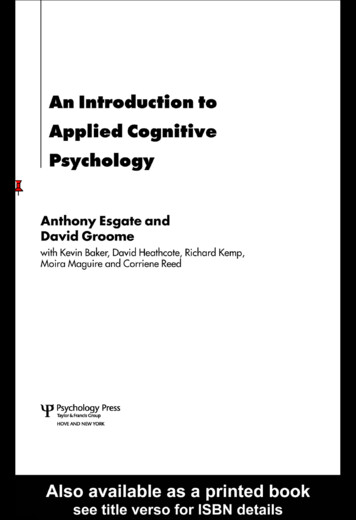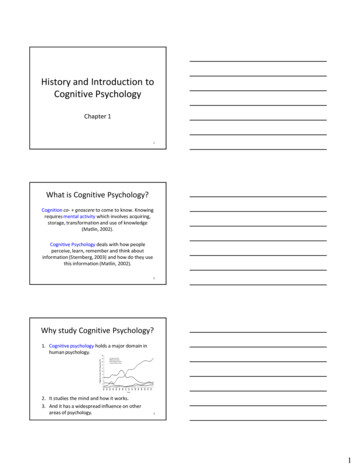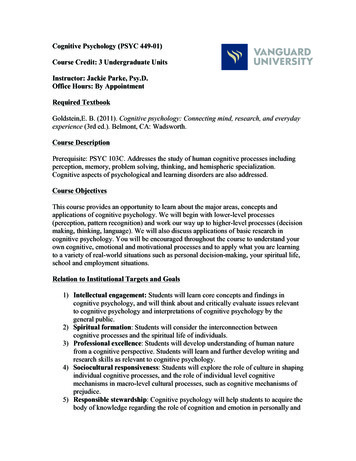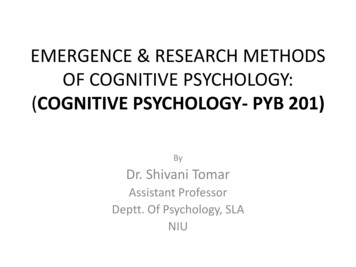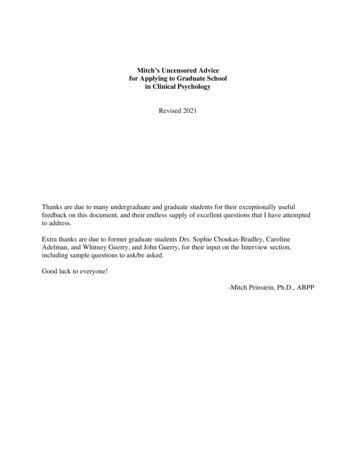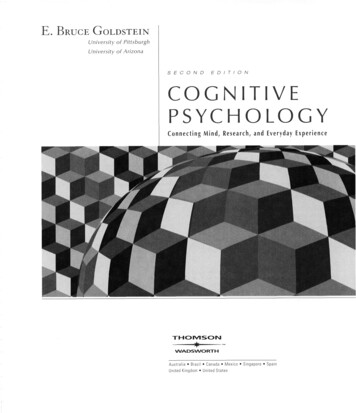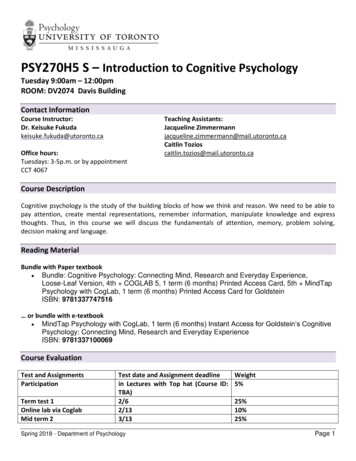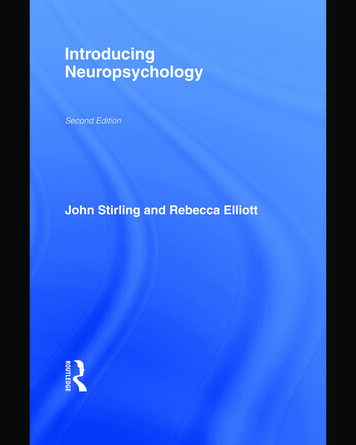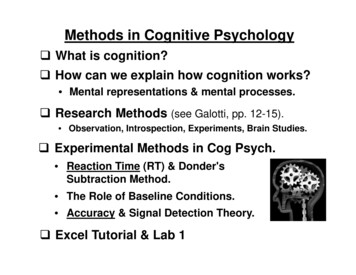
Transcription
Methods in Cognitive Psychology What is cognition? How can we explain how cognition works? Mental representations & mental processes. Research Methods (see Galotti, pp. 12-15). Observation, Introspection, Experiments, Brain Studies. Experimental Methods in Cog Psych. Reaction Time (RT) & Donder'sSubtraction Method. The Role of Baseline Conditions. Accuracy & Signal Detection Theory. Excel Tutorial & Lab 1
Mental Representations A representation is a physical state (e.g., marks on apage, magnetic fields in a computer, neural connectionsin the brain) that stands for something. Representations have two characteristics: A format(how it's realized) and a content (what it stands for). A lot of work in cognitive psychology is devoted tounderstanding the nature of mental and/or neuralrepresentations. Examples of mental representations include Memory traces. Words in our "mental lexicon" (mind's dictionary). Concepts. Images.
Mental Processes Representations don’t do anything unless they areprocessed (or interpreted). A process is the transformation of an input (e.g., twonumbers) into an output (e.g., a sum). Much work in cog psych is directed at discoveringmental processes & understanding how they work. Most interesting cognitive activities (e.g., memory,thinking) reflect the operation of multiple processes. Examples of mental processes include Visual search. Short-term memory. Selective Attention. Executive functions (planning, inhibition, etc.).
How many guysdid you go outwith in college?Oh, I never datedmuch in tionDecision abouthow to answerSpeechproduction events like this occur veryquickly; how can we "breakthem down" to understandthe representations andprocesses involved?
Reaction Time (RT) the time it takes to respondto something; usually thetime between some stimulus(S) and some response (R). sometimes referred to as"mental chronometry". many cognitive processesoccur very quickly and thus aremeasured in milliseconds (ms);1 ms 1/1000th of a second.
Reaction Time (RT)Is Visual Search Serial or Parallel?Do we search theworld serially,examining one itemat a time?Or do we search inparallel,simultaneouslyexamining all theobjects in our visualfield?
Reaction Time (RT)
Reaction Time (RT)Processing stages andDonder's (1868) subtraction methodDetectionCategorizationResponse SelectionResponding
Simple RT Task* * RT Detection Responding.
Complex (Choice) RT Task*circle key 1square key 2 * RT Detection Categorization Response Selection Responding.
Subtraction MethodDonders (1868)DetectionChoice RT 500 msCategorizationResponse SelectionResponding- Simple RT 350 ms150 ms Categorization andResponse Selection
Methods in Cognitive Psychology What is cognition? How can we explain how cognition works? Mental representations & mental processes. Research Methods (see Galotti, pp. 19-23). Observation, Introspection, Experiments, Brain Studies. Experimental Methods in Cog Psych. Reaction Time (RT) & Donder'sSubtraction Method. The Role of Baseline Conditions. Accuracy & Signal Detection Theory. Excel Tutorial & Lab 1
The Role of Baseline ConditionsAmount of sleepMemoryperformance1 hour65%8 hours68%Baseline conditionTake-Home Message: You can't learnmuch from an expt without an appropriatebaseline or comparison condition.
The Role of Baseline ConditionsImagine you want to test people's memory. To do so, you showthem a list of 50 words and then, after a delay, show themthose words again and ask if they remember seeing any on theprevious list (saying "yes" if they did, "no" if they didn't).Studied words Unstudied words(% "yes")(% "yes")Subject A85%75%Subject B65%15%HitsFalseAlarms
Accuracy in Detecting SignalsStimulus RMMISSCORRECTREJECTION
Signal Detection TheoryDoes the "star field" to the leftcontain a set of 10 equidistant dotsarranged in straight line that slantsdownward from left to right?Stimulus Present?Yes"Yes"Person A:Person B:NoHITFALSEALARM90%60%50%20%
Signal Detection Theory Assumes that detection reflects 2 processes.1. Sensitivity - Person's true ability to discriminatetargets (signal) from non-targets (noise).2. Response Criterion (Bias) - Person's tendencyto claim they have detected a signal ("yes").probability"No"Rsp. Crit."Yes"SensitivitySignaltrialsNoisetrialssignal strength
Signal Detection TheoryCorrect RejectionsMissesprobability"No"HitsFalse AlarmsRsp. Crit."Yes"SensitivitySignaltrialsNoisetrialssignal strength
Signal Detection Theory Applies to.MemoryMedical Decisions Radar OperatorsBaseballetc. etc. etc."No"probability Rsp. Crit."Yes"SensitivitySignaltrialsNoisetrialssignal strength
Signal Detection TheorySituation A:Hit 10FA - 1Stimulus Present?Situation B:Hit 1FA - 10YesNoHITFALSEALARMSituation A:90%70%Situation B:45%5%"Yes"
Type I & Type II Errors Type I & Type II errors have many real-world consequences.- In the hospital. False AlarmHitCorrect Reject.- False AlarmHitCorrect Reject.MissMiss In court decisions.-
Methods in Cognitive Psychology What is cognition? How can we explain how cognition works? Mental representations & mental processes. Research Methods (see Galotti, pp. 19-23). Observation, Introspection, Experiments, Brain Studies. Experimental Methods in Cog Psych. Reaction Time (RT) & Donder'sSubtraction Method. The Role of Baseline Conditions. Accuracy & Signal Detection Theory. Lab 2: Signal Detection.
Methods in Cognitive Psychology Experimental Methods in Cog Psych. The Role of Baseline Conditions. Accuracy & Signal Detection Theory. Reaction Time (RT) & Donder's Subtraction Method. What is cognition? How can we explain how cognition works? Mental representations & mental processes. Research Methods
